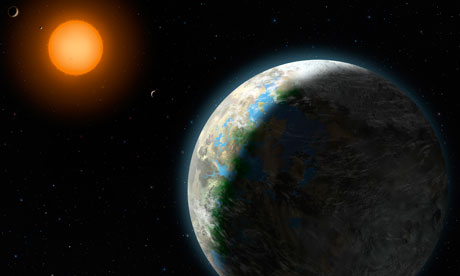太空探索研究人員最近發現了一顆大小類似地球的行星,這顆行星圍繞離地球20光年的一顆恒星運轉,其表面溫度適宜產生液態水源,因而很有可能是另一個適合生物存活的星球。據研究人員介紹,這顆被命名為Gliese 581g的行星是已發現的圍繞紅矮星Gliese 581運轉的六顆行星之一,也是這其中唯一一顆位于“可居住區”的行星。研究人員稱,這顆行星很可能是一顆巖石行星,具有足夠的引力維持穩定的大氣層,而且它總是始終保持一面朝向恒星,使其一側永久處于陽光之中,而另一側永久在黑暗之中;這種特征有助于穩定行星的表面氣候,而黑暗和陽光的交界處則是最適宜生物生存的區域。

 |
|
An artist's impression of Gliese 581g, which astronomers say is near Earth - relatively speaking - at 120 trillion miles.(Agencies) |
Astronomers have discovered a potentially habitable planet of similar size to Earth in orbit around a nearby star.
A team of planet hunters spotted the alien world circling a red dwarf star called Gliese 581, 20 light years away.
The planet is in the "Goldilocks zone" of space around a star where surface temperatures are neither too hot nor too cold for liquid water to form.
"Our findings offer a very compelling case for a potentially habitable planet," said Steven Vogt, an astronomer at the University of California, Santa Cruz. "The fact that we were able to detect this planet so quickly and so nearby tells us that planets like this must be really common."
If confirmed, the planet would be the most Earth-like that has ever been discovered in another solar system and the first strong contender for a habitable one.
More than 400 exoplanets have been discovered by astronomers, but most are gas giants, like Jupiter, that would be inhospitable to life as we know it.
Astronomers used the Keck telescope in Hawaii to study the movement of Gliese 581 in exquisite detail and from their observations inferred the presence of a number of orbiting planets. The team report two new planets in the Astrophysical Journal, bringing the total number known to be circling the star to six.
One of the planets, named Gliese 581g, has a mass of three to four times that of Earth and takes 37 days to orbit the star. Astronomers believe it is a rocky planet with enough gravity to retain an atmosphere.
Unlike the previously discovered planets, Gliese 581g lies squarely in the region of space where life can thrive. "We had planets on both sides of the habitable zone — one too hot and one too cold — and now we have one in the middle that's just right," Vogt said.
One side of the planet is always facing the star, much as one side of the moon constantly faces Earth. This means that the far side of the planet is constantly in darkness. The most habitable region of the planet would be the line between the light and dark regions.
"Any emerging life forms would have a wide range of stable climates to choose from and to evolve around, depending on their longitude," Vogt said.
The average temperature on the planet is estimated to be between -31 to -12C, but the ground temperature would vary from blazing hot on the bright side and freezing on the dark side.
"The number of systems with potentially habitable planets is probably on the order of 10 or 20 percent, and when you multiply that by the hundreds of billions of stars in the Milky Way, that's a large number. There could be tens of billions of these systems in our galaxy," said Vogt.
相關閱讀
(Agencies)

Vocabulary:
Goldilocks zone: Also called the habitable zone or life zone, the Goldilocks Zone is an area of space in which a planet is just the right distance from its home star so that its surface is neither too hot nor too cold. That means that the planet could possibly host liquid water. 可居住區,指與運轉軌道中心的恒星距離適當,表面溫度不冷也不熱,能夠保持液態水的區域。
(中國日報網英語點津 Helen 編輯)